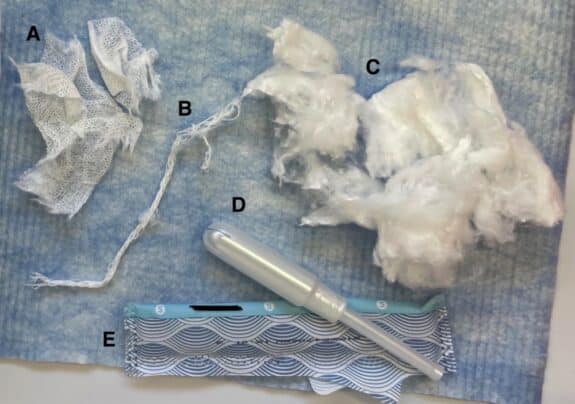A recent study led by researchers at UC Berkeley has uncovered alarming findings about the presence of toxic metals in tampons—a product used monthly by millions of menstruating individuals.
The UC Berkeley-led study evaluated levels of 16 metals (arsenic, barium, calcium, cadmium, cobalt, chromium, copper, iron, manganese, mercury, nickel, lead, selenium, strontium, vanadium, and zinc) in 30 tampons from 14 different brands. Researchers found that several of these toxic metals were present in these products. The study highlighted that tampons could be a significant source of metal exposure due to the high absorption capacity of vaginal skin.
“Although toxic metals are ubiquitous and we are exposed to low levels at any given time, our study clearly shows that metals are also present in menstrual products and that women might be at higher risk for exposure using these products,” said study co-author Kathrin Schilling, assistant professor at Columbia University Mailman School of Public Health.
Key Findings
- Presence of Metals: The study detected concentrations of all 16 tested metals in tampons from different brands and types. Notably, lead concentrations were higher in non-organic tampons, while arsenic levels were elevated in organic tampons.
- High Concentrations: The highest concentration found was for zinc, with a geometric mean of 52,000 ng/g. Lead had a geometric mean concentration of 120 ng/g, which is particularly concerning given that there is no safe level of lead exposure.
- Variability in Metal Levels: Metal concentrations varied depending on where the tampons were purchased (US vs. EU/UK), whether they were organic or non-organic, and whether they were store-brand or name-brand.
Alarmingly, the team discovered the presence of lead (Pb) in all tested tampons. No level of lead exposure is considered safe, as any amount that may leach from a tampon into the bloodstream could lead to harmful health effects. Lead accumulates in bones, substituting calcium (Ca), and can remain in the body for decades.

VIA UC Berkeley – Fig. 1. A tampon separated into its components, including the (A) non-woven outer covering, (B) withdrawal string, (C) inner absorbent core, (D) applicator, and (E) wrapper.
Health Risks Associated with Metal Exposure
Exposure to toxic metals can have severe health implications. Metals like lead, arsenic, and cadmium are known to increase the risk of several diseases and health conditions, including:
- Neurological Effects: Lead exposure, even at low levels, can result in neurobehavioral impacts such as decreased cognitive function, impaired attention, memory, and learning abilities.
- Reproductive Health: Metals can damage the reproductive system, causing infertility and adverse effects on fetal development.
- Systemic Damage: Metals can harm the liver, kidneys, brain, cardiovascular system, and endocrine system, leading to chronic diseases like diabetes and cancer.
Several factors contribute to the presence of metals in tampons:
- Contaminated Raw Materials: Cotton, rayon, or viscose used in tampons may be contaminated during production through atmospheric deposition or wastewater application.
- Manufacturing Process: Metals may be introduced through contaminated water used in manufacturing or intentionally added for various purposes, such as antimicrobial properties or odor control.
- Pigments and Additives: Metals are sometimes used as pigments to color tampon applicators or as lubricants to aid in smooth insertion.
Differences Between Organic and Non-Organic Tampons
The study found notable differences in metal concentrations between organic and non-organic tampons. Organic tampons, often made from 100% cotton, showed higher levels of arsenic, potentially due to the use of natural fertilizers in organic farming. Non-organic tampons, made from rayon or a cotton/rayon mix, had higher levels of lead.
Current Regulations and the Need for Change
In the US, tampons are regulated by the Food and Drug Administration (FDA) as medical devices, but there are no stringent requirements for testing chemical contaminants. Similarly, in the EU, tampons follow a code of “good practice” without mandatory testing for toxic metals.
Given the potential health risks, we must advocate for better regulation and transparency in menstrual product manufacturing.
“I really hope that manufacturers are required to test their products for metals, especially for toxic metals,” said Shearston. “It would be exciting to see the public call for this, or to ask for better labeling on tampons and other menstrual products.”
The presence of toxic metals in tampons is a significant public health concern that requires immediate attention. Future research and stricter regulations are essential to ensure that menstrual products are safe for all users.







